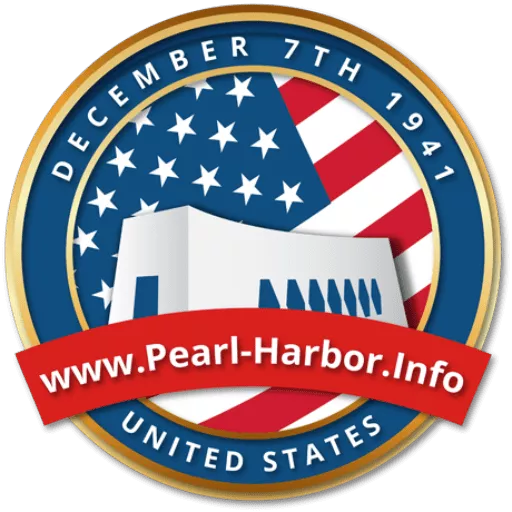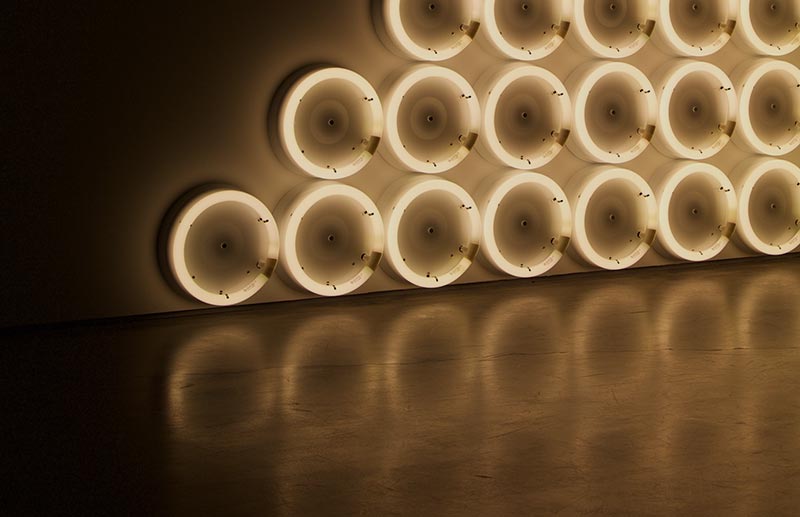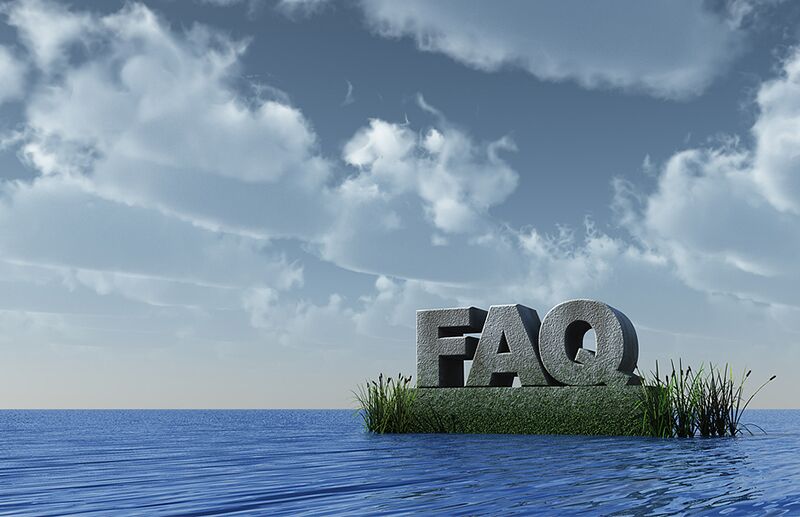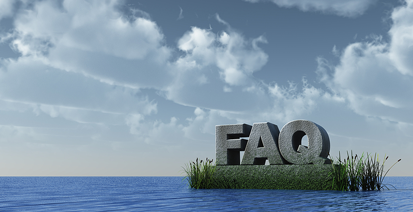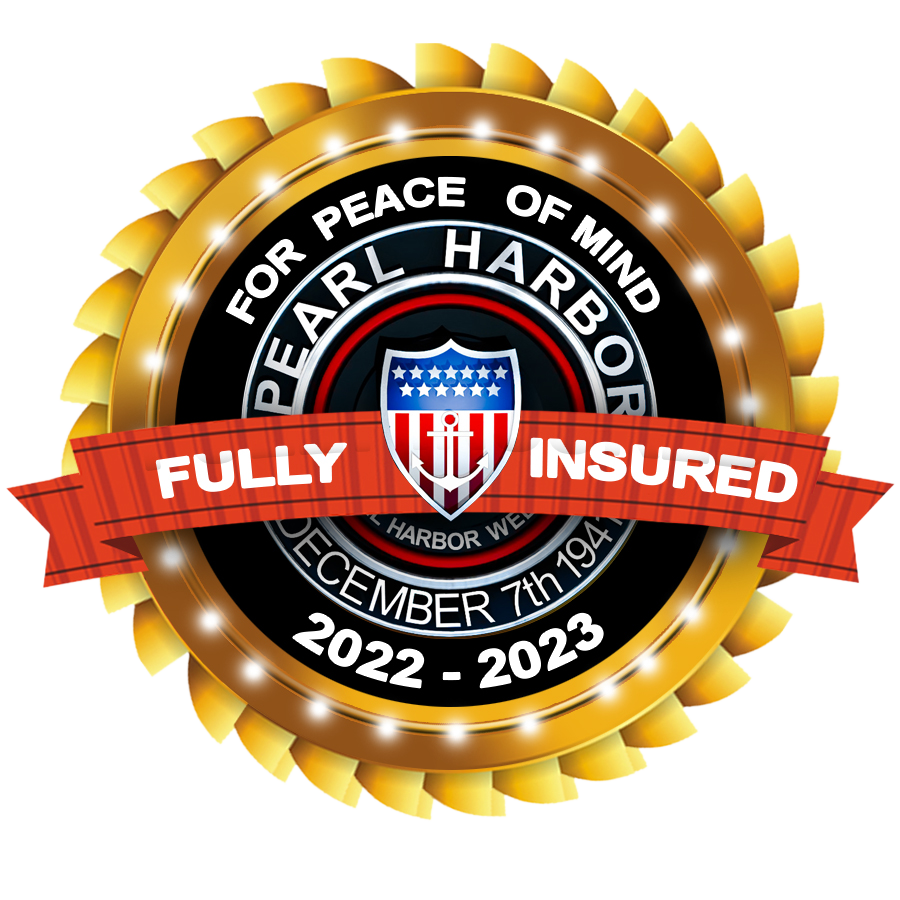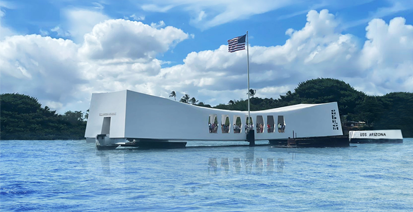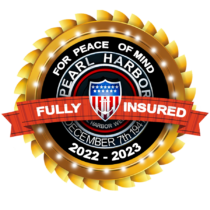Major Battles Of The Pacific Theater
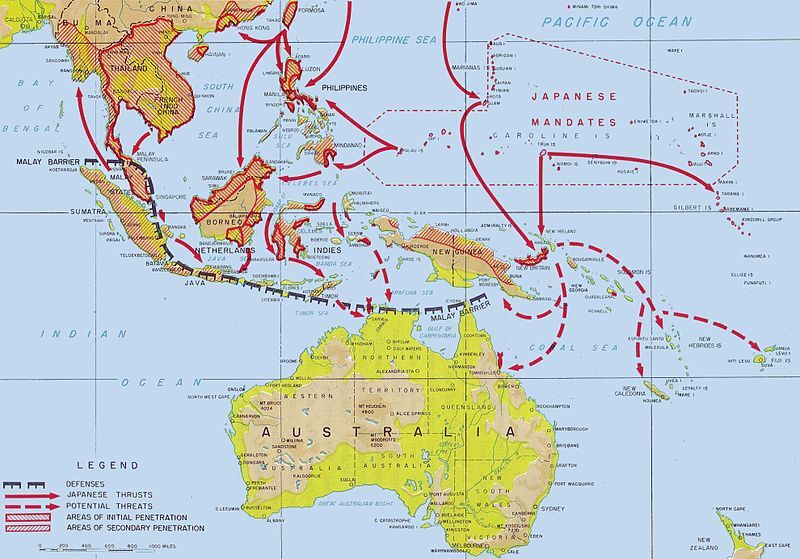
Map of Imperial Japanese advances in the Southwest Pacific and Southeast Asia areas during the first five months of the Pacific Campaign of World War II., MacArthur’s General Staff, United States Army Center of Military History. The Campaigns of MacArthur in the Pacific, Volume I. Reports of General MacArthur. Retrieved on 2006-12-08., p. 24 ([1]), PD-USGov
War in the Pacific, during World War II, was fought between the Empire of Japan against the Allied Forces that included the US, Britain, Netherlands, and Australia. Although the Pearl Harbor attack occurred on Dec 7th, it was already Dec 8th in Japan, and thus this is considered the official date of the beginning of World War II in the Pacific. On December 8, 1941, Japan attacked Guam, Thailand, Malaya, Singapore, Wake Island, and Hong Kong.
Battle of Singapore
Two months after the attack on Pearl Harbor, on Feb 8, 1945, the Japanese made an all-attack on Singapore. Controlled by the British, the Allies had 90,000 troops on the Island under the command of General Arthur Percival. The Japanese unexpectedly attacked from the jungle side of the Island with 36,000 soldiers led by General Tomoyuki Yamashita. After seven days of desperate fighting, the Allied force surrendered, and 80,000 men were taken as prisoners. Historians considered this the worst military disaster in the history of England.
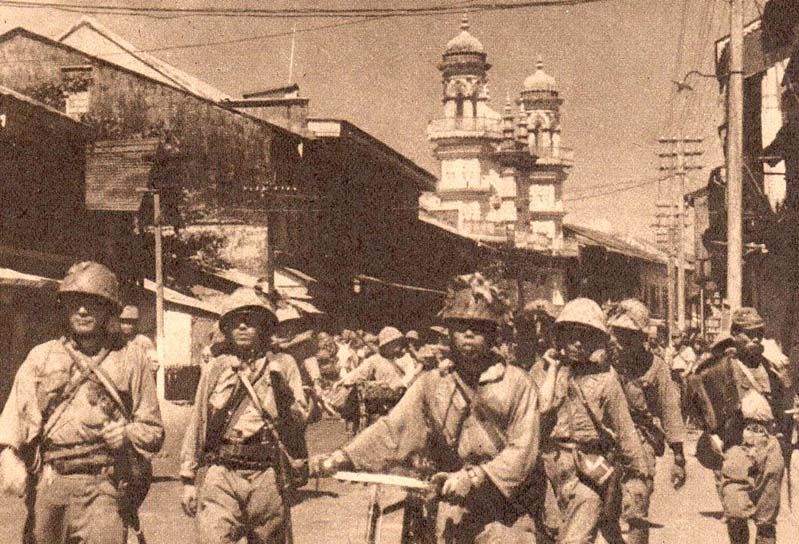
Japanese troops at Singapore, Unknown author, http://forum.axishistory.com/viewtopic.php?f=65&t=162279&start=0, PD-JPN-US

The Royal Navy heavy cruiser HMS Exeter (68) sinking after the Battle of the Java Sea, 1 March 1942., Photo taken from a Japanese aircraft, Imperial Japanese Navy; this photo was captured by U.S. Forces on Attu Island, Alaska in 1943 and became U.S. Navy photo 80-G-179020 from the U.S. Navy Naval History and Heritage Command, PD-JPN, PD-USGov
Battle of Java Sea
The Java Sea is between Java and Kalimantan in the Dutch Indies. On Feb 27, 1942, this famous sea battle occurred between the Imperial Japanese fleet and an Allied Fleet of US, British, Dutch, and Australian ships. The Allied goal was to stop the Japanese invasion of the Dutch East Indies (called Indonesia today). The Japanese dominated the battle by sinking two heavy cruisers and three destroyers, causing 2,300 men to die, including Commander Karel Doormen. The Japanese had no losses, and the invasion was only postponed by one day, an overwhelming victory for Japan.
Battle of Coral Sea
The Coral Sea is located between Australia, New Guinea, and the Solomon Islands. This four-day intense aircraft carrier battle occurred between the Japanese and American fleets between May 4-8, 1942. It was entirely fought with planes, and no ship-to-ship firing happened; each side was evenly matched, with two aircraft carriers and approximately 140 aircraft.
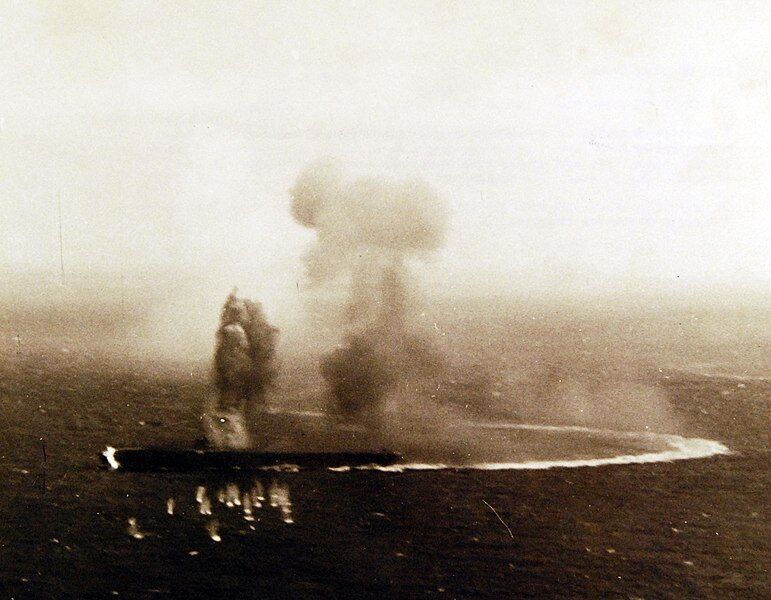
80-G-17030A: Battle of Coral Sea, May 1942. Japanese aircraft carrier Shokaku attacked by USS Yorktown (CV-5) planes, during the morning of 8 May 1942. Flames from a bomb hit on her forecastle are visible, as are smoke and splashes from dive bombers’ near misses off her starboard side. Photographed from a Torpedo Squadron Five TBD-1. What appear to be erratic torpedo tracks are visible in the lower left. Official U.S. Navy Photograph, now in the collections of the National Archives. A close up of 80-G-17030, National Museum of the U.S. Navy, 80-G-17030A, PD-USGov
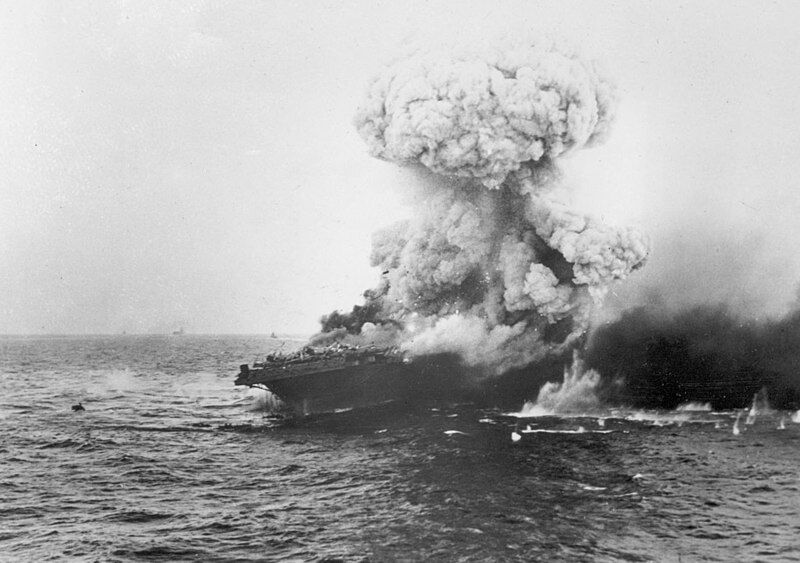
A mushroom cloud rises after a heavy explosion on board the U.S. Navy aircraft carrier USS Lexington (CV-2), 8 May 1942. This is probably the great explosion from the detonation of torpedo warheads stowed in the starboard side of the hangar, aft, that followed an explosion amidships at 1727 hrs. Note USS Yorktown (CV-5) on the horizon in the left center, and destroyer USS Hammann (DD-412) at the extreme left., U.S. Navy photo 80-G-16651, Naval History and Heritage Command under the digital ID 80-G-16651, PD-USGov
The US withdrew first and lost the carrier Lexington; another carrier was damaged, and a destroyer and an oiler sunk, with 530 deaths. The Japanese lost the carrier Shoho, a destroyer, three small Navy ships were sunk, and 966 sailors were killed in the battle. Both sides declared victory in the Battle of the Coral Sea.
Battle of Guadalcanal
Guadalcanal is the largest of the Solomon Islands, northeast of Australia. The battle is known as the turning point in Japanese expansion in the Pacific during World War II and is often referred to as a campaign because of the long duration of the conflict and how significant battles were fought on land and sea. The conflict started on Aug 7, 1942, with the US Marines invading and capturing the Japanese airfield.
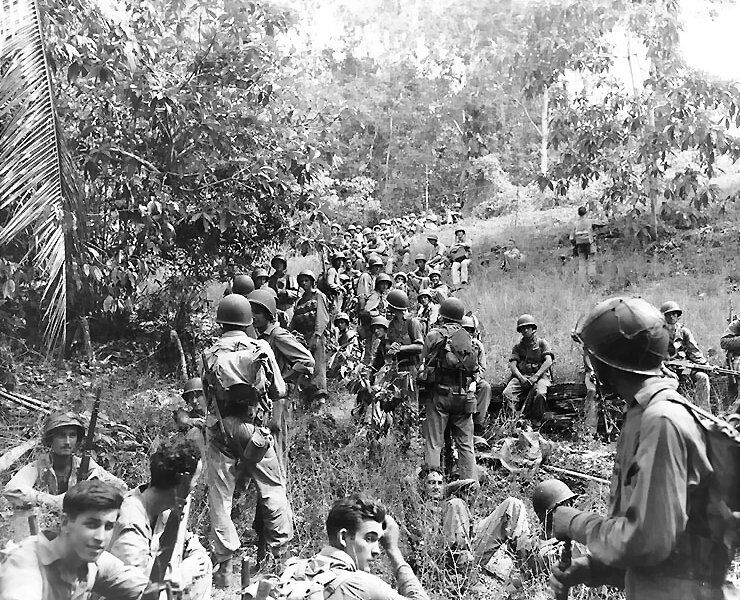
Troops from the armies 164th infantry rest at a stand still at Guadalcanal., unknown author, US Navy Photo #: 80-G-20683; or: http://www.ibiblio.org/hyperwar/USMC/USMC-M-Guadalcanal/USMC-M-Guadalcanal-8.html, PD-USGov
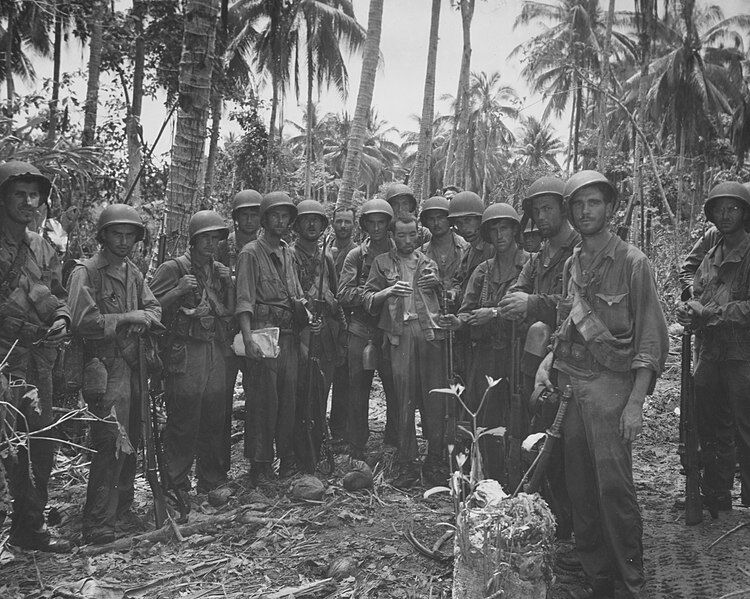
A Marine patrol with a Japanese prisoner on Guadalcanal., Signal Corps Archive from Ireland and United States, A Marine patrol with a Japanese prisoner on Guadalcanal., PD-USGov
It took six months to capture the entire Island from the Japanese. The Japanese gave up Guadalcanal after losing 24,000 men, 680 planes, and 24 warships. The US also had heavy losses, with 7,100 deaths, 615 aircraft lost, and 24 warships destroyed. A definite victory for the US; not only was the Japanese expansion halted in the Pacific, by the Allied shipping and communication lines to Australia remained open.
Battle of Saipan
Saipan and Tinian were Japanese colonies since receiving them after World War I from Germany. During the beginning of World War II, the Japanese high command decided to fortify Saipan, Guam, and Tinian to ensure they would never fall into Allied hands. Their concern was that the US-based B-29 bombers could reach and bomb Japan from these three islands.
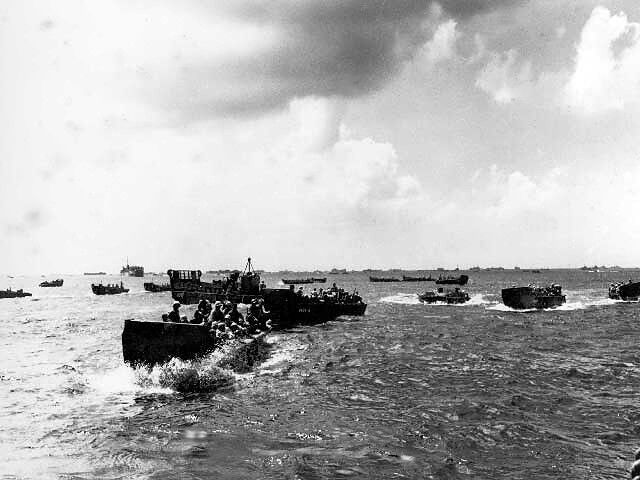
Landing craft with battle ready troops move towards Saipan beachhead., User:W.wolny, - National Park Service - (National Archives), PD-USGov
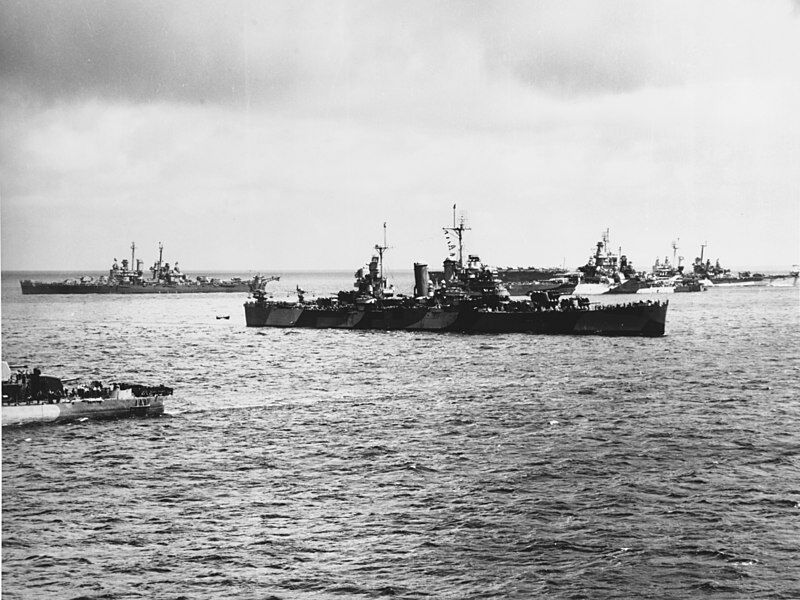
Saipan Operation, June 1944: U.S. Navy ships of Task Force 52 prepare to depart Roi for Saipan, 12 June 1944. The ships are (left to right): the destroyer USS McNair (DD-679); the light cruiser USS Montpelier (CL-57); USS Honululu (CL-48); and the battleship USS Tennessee (BB-43). Another cruiser and an escort carrier are in the background., U.S. Navy, photographed from USS New Mexico (BB-40)., Official U.S. Navy photo 80-G-253678 from the U.S. Navy Naval History and Heritage Command, PD-USGov
On Feb 15, 1944, the Allied made an all-out assault on Saipan, with an Armada of 535 ships carrying 127.000 military personnel, to face the 32,000 Japanese defenders. The battle began on June 15, 1944, and lasted 24 grueling and bloody days, ending with the deaths of 30,000 Japanese soldiers and all of their top officers. The US lost 3,500 fatalities and over 13.000 casualties.
Battle of the Philippine Sea
Fought off the coast of Saipan, just four days after the invasion of the Island, the Japanese and American carriers met on June 19, 1944. The goal of the Japanese was to defeat the American fleet and stop the assault on Saipan; the US goal was to destroy the Japanese fleet and safeguard the 500 ships and troops on Saipan.
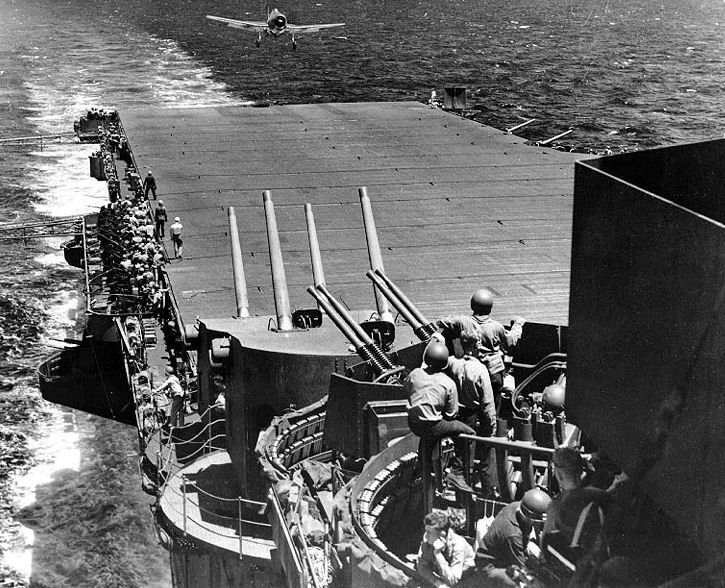
Grumman F6F-3 fighter landing aboard the Essex Class carrier USS Lexington (CV-16) - flagship of Task Force 58 - during the Battle of the Philippine Sea, June 1944., Official US Navy Photograph. (Enhancement by DLJ - Wild Surmise), US Navy images http://www.history.navy.mil/photos/sh-usn/usnsh-l/cv16.htm, PD-USGov
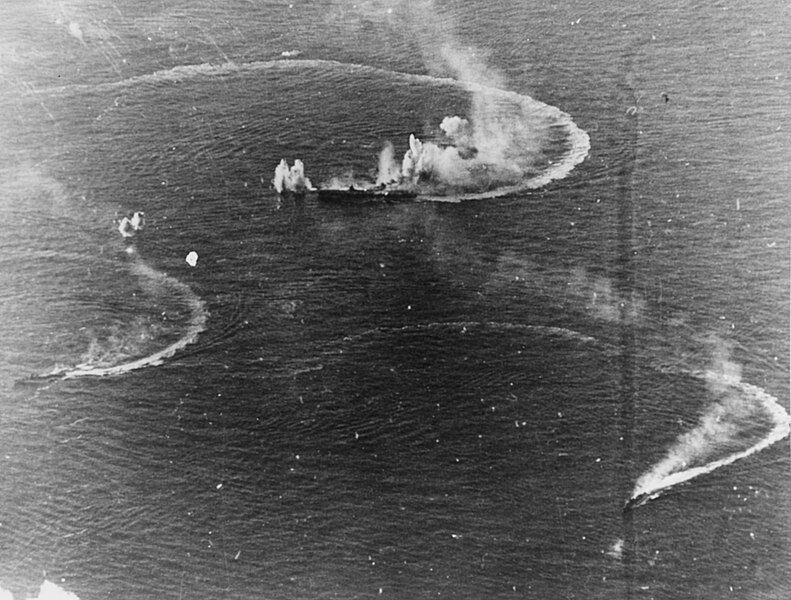
Battle of the Philippine Sea: the Japanese aircraft carrier Zuikaku (center) and the destroyers Akizuki and Wakatsuki maneuvering, while under attack by U.S. Navy carrier aircraft, during the late afternoon of 20 June 1944. Zuikaku was hit by several bombs during these attacks, but survived., Unknown author, U.S. Navy photo 80-G-238025, PD-USGov
It was an overwhelming victory for the Americans, three Japanese carriers were sunk, and 400 aircraft were destroyed. The Japanese Navy was severely weakened, and the Japanese Airforce was devastated and would never be the same.
Battle of Leyte Gulf
The strategic island of Leyte in the Philippines was wanted by both the Japanese and Americans due to its harbor, which, like Pearl Harbor, was a perfect port for warships. During World War II, the Battle of Leyte Gulf became the largest naval battle in the history of man, involving 270 warships.
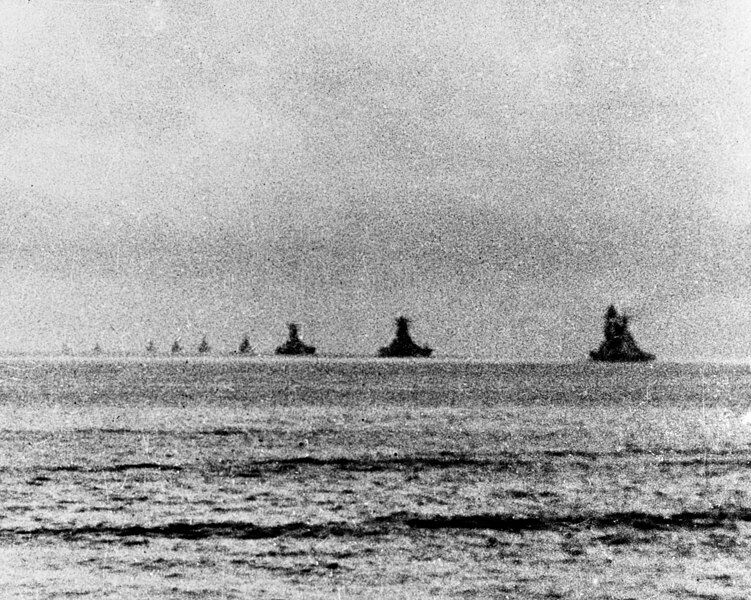
Battle of Leyte Gulf, October 1944: The Japanese “Center Force” leaves Brunei Bay, Borneo, on 22 October 1944, en route to the Philippines. Ships are, from right to left: battleships Nagato, Musashi and Yamato; heavy cruisers Maya, Chōkai, Takao, Atago, Haguro and Myōkō., Unknkown Author, U.S. Navy photo NH 63435, PD-USGov, PD-JPN
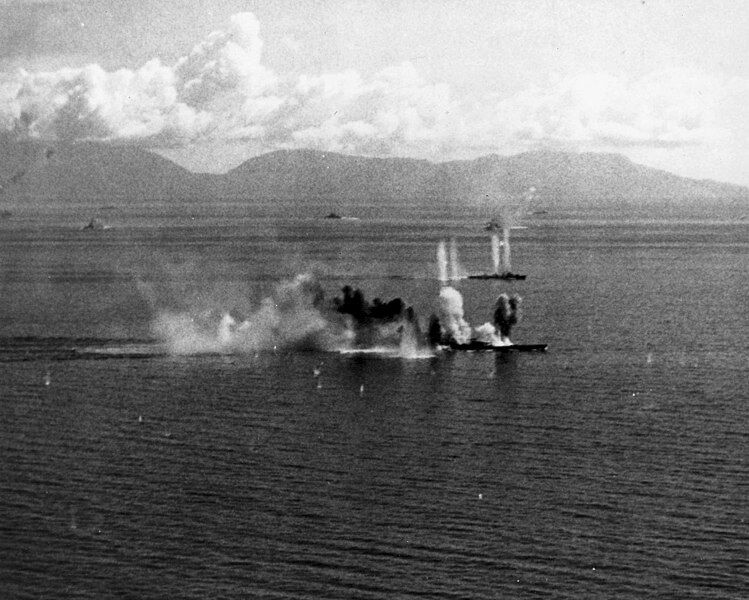
U.S. Navy Task Force 38 aircraft attack the Japanese battleship Musashi (foreground) and a destroyer in the Sibuyan Sea, 24 October 1944., U.S. Navy, U.S. Navy photo NH 63432, PD-USGov
It resulted in a stunning victory for the Allies. Japan lost four carriers, three battleships, ten large cruisers, eleven destroyers, and 12,000 sailors and officers. In contrast, the Allies lost three carriers, three destroyers, and 2,500 casualties.
The Battle of Leyte was a total disaster for the Imperial Navy that they never recovered from for the remainder of World War II.
Battle of Iwo Jima
The Battle of Iwo Jima will go down in history as one of the fiercest battles of World War II. Iwo Jima is a small island, only five by 2.5 miles, located about 760 miles south of Tokyo. The battle became known worldwide due to the Associated Press picture of the US flag raising on Mount Suribachi.
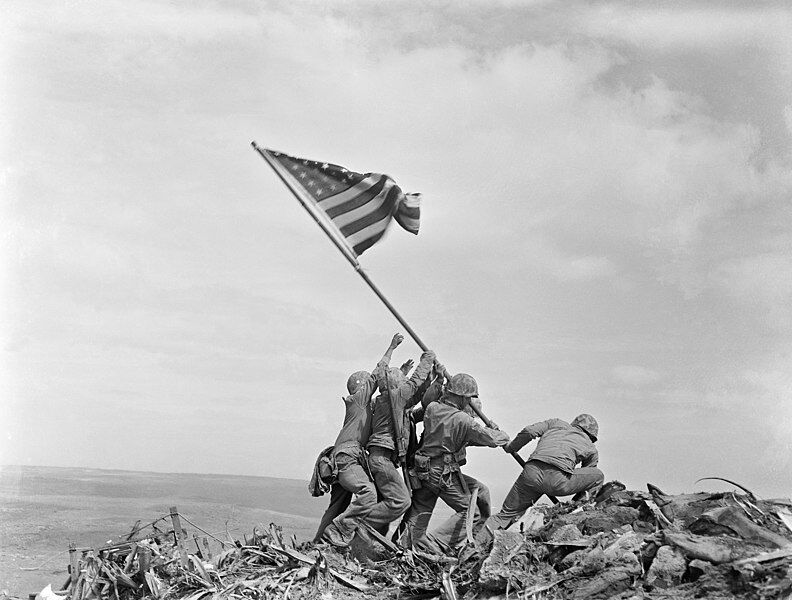
Photograph of Flag Raising on Iwo Jima, Joe Rosenthal, General Records of the Department of the Navy (NAID 409), NWDNS-80-G-413988, PD-US
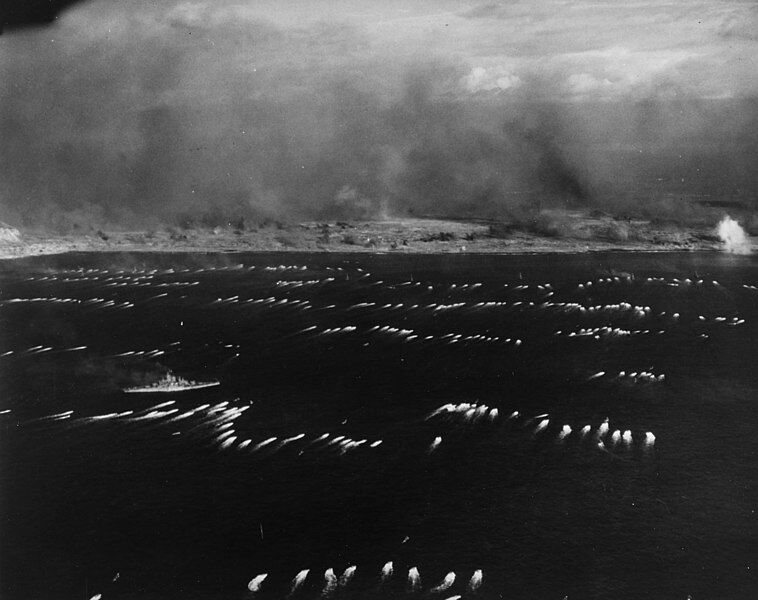
Iwo Jima Operation, 1945: Initial waves of amphibious tractors (LVT) head for the landing beaches on Iwo Jima’s southeastern coast, at about 0900 hrs on 19 February 1945. The U.S. Navy battleship USS Tennessee (BB-43) is at left. The photo was taken from an airplane based aboard the escort carrier USS Makin Island (CVE-93)., U.S. Navy photo 80-G-310951, Naval History & Heritage Command, PD-USGov
An Allied Fleet of 450 ships descended on Iwo Jima with 70,000 hardened Marines, which faced 22,000 Japanese defenders in which all but 1,000 were killed. The battle raged for 34 days, from Feb 19 to March 26, 1945. The victory was not easy, with 20,000 American wounded and 6,800 killed.
Battle of Okinawa
The last major battle of World War II in the Pacific was fought on the island of Okinawa, which the Japanese considered part of their homeland. Located just 400 miles south of Kyushu, Japan, the Island is 66 miles long and 7 miles wide. It is known for being one of the war’s bloodiest battles because of the well-organized and fierce resistance that lasted for 83 days, beginning on April 1, 1945.
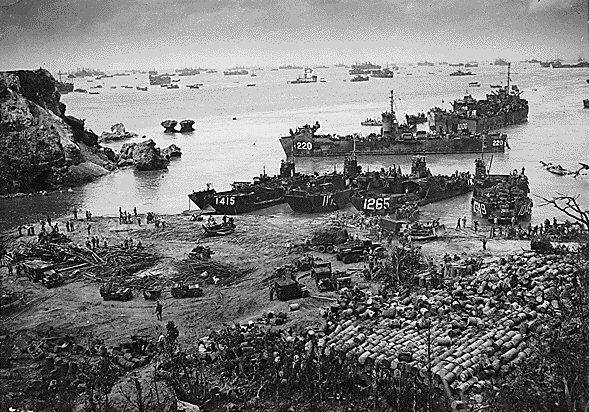
Okinawa - American LCTs unload supplies on Yellow Beach near the mouth of the Bishi Gawa river on 13 April 1945, Post-Work: User:W.wolny, Origianl author unknown, https://arcweb.archives.gov/arc/, PD-USGov
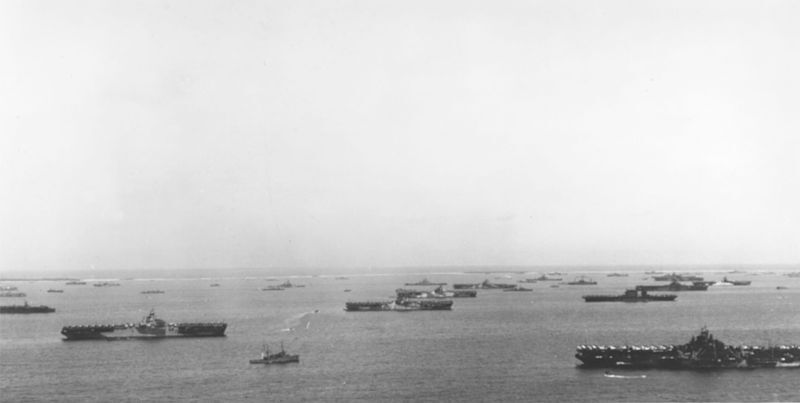
Ships of the U.S. Navy Pacific fleet anchored at Ulithi Atoll, Caroline Islands, circa 7-10 February 1945, just prior to the Iwo Jima operation. The aircraft carrier USS Saratoga (CV-3) is in the right middle distance. There are at least eight Essex-class carriers present., U.S. Navy, Official U.S. Navy photo 80-G-347155 from the U.S. Navy Naval History and Heritage Command, PD-USGov
Imagine, 1300 ships were sent to the Battle of Okinawa, including a sizeable British carrier group. Never has a battle in the Pacific seen such a fleet of warships, which were guarding and transporting an invasion force of 180,000 US Marines and Army soldiers. This became the largest amphibious landing of War in the Pacific.
The Japanese were relentless in their defense and even threw ten mass Kamikazes suicide bombers with hundreds of planes against the invading Allied fleet. The mass suicide of Japanese pilots did not stop the invasion but cost the fleet a depressing 4,900 naval causalities.

Kamikaze attack on the USS Missouri (BB-63). About to be hit by a Japanese A6M "Zero" kamikaze, while operating off Okinawa on 11 April 1945. The plane hit the ship's side below the main deck, causing minor damage and no casualties on board the battleship. A 40 mm quad gun mount's crew is in action in the lower foreground. The kamikaze on the photo has been identified as either Flight Petty Officer 2nd Class Setsuo Ishino or Flight Petty Officer 2nd Class Kenkichi Ishii., Harold "Buster" Campbell according to USS Missouri Memorial Association or Len Schmidt according to Naval and Heritage Command, NavSource, PD-USGov
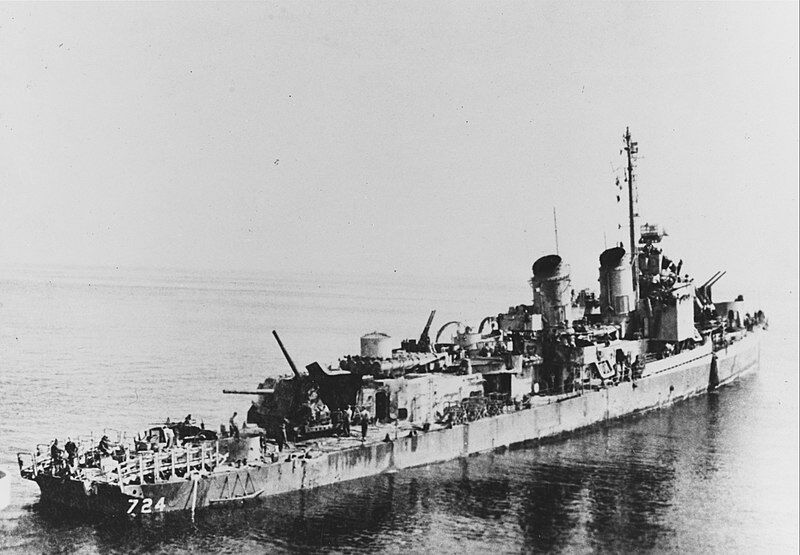
Photographed from USS PCE-851, on Okinawa Radar Picket Station Number One, after being hit by five kamikazes, two bombs, and some near misses, on 16 April 1945., Courtesy of F.S. Bayley, Jr., Seattle, Washington, 1950s., Unknown author, https://www.history.navy.mil/content/history/nhhc/our-collections/photography/numerical-list-of-images/nhhc-series/nh-series/NH-78000/NH-78233.html, PD-USGov
The loss of life was tremendous for both sides and the civilians of Okinawa. The Japanese lost approximately 100,000 soldiers, the locals also lost 100,000 lives, about 30 % of the Island’s population, and the Americans suffered 12,500 killed and another 37,500 wounded. The US military high command knew they got a taste of what it would be like to invade mainland Japan.
